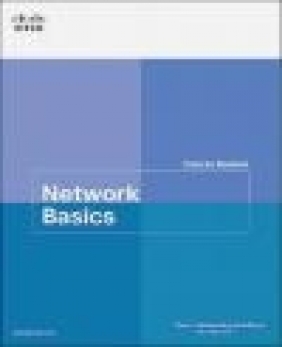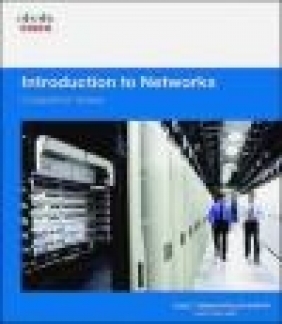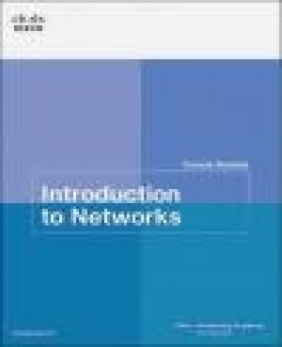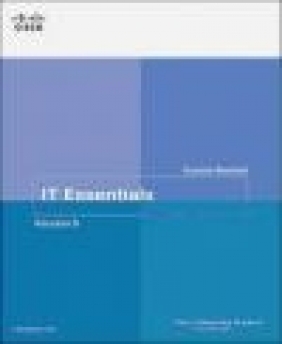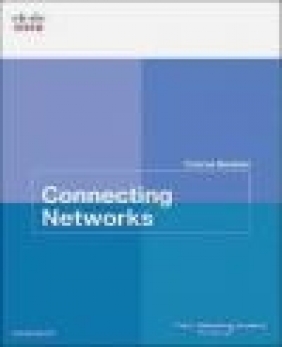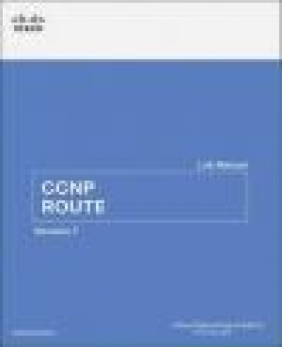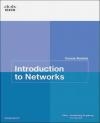Introduction to Networks Course Booklet
Cisco Networking Academy
Introduction to Networks Course Booklet
Cisco Networking Academy
- Producent: Cisco Press
- Rok produkcji: 2013
- ISBN: 9781587133114
- Ilość stron: 360
- Oprawa: Miękka
Niedostępna
Opis: Introduction to Networks Course Booklet - Cisco Networking Academy
The Introduction to Networks Course Booklet offers a way for students enrolled in a Cisco Networking Academy introduction to Networks course to easily read, highlight, and review on the go, wherever the Internet is not available. The text is extracted directly from the online course, with headings that have exact page correlations to the online course. An icon system directs the reader to the online course to take full advantage of the images, labs, Packet Tracer activities, and dynamic activities. The books are intended to be used with the course.Chapter 0 Course Introduction 1 0.0 Welcome to Introduction to Networks 1 0.0.1 Message to the Student 1 0.0.1.1 Welcome 1 0.0.1.2 A Global Community 1 0.0.1.3 More Than Just Information 1 0.0.1.4 How We Teach 2 0.0.1.5 Practice Leads to Mastery 2 0.0.1.6 Mind Wide Open 2 0.0.1.7 Engineering Journals 2 0.0.1.8 Explore the World of Networking 2 0.0.1.9 Create Your Own Worlds 2 0.0.1.10 How Packet Tracer Helps Master Concepts 3 0.0.1.11 Course Overview 3 0.1 Navigating the Course 3 0.1.1 Control Your Experience 3 0.1.1.1 Course GUI Tutorial 3 Your Chapter Notes 4 Chapter 1 Exploring the Network 5 1.0 Exploring the Network 5 1.0.1.1 Introduction 5 1.0.1.2 Class Activity - Draw Your Concept of the Internet 5 1.1 Globally Connected 6 1.1.1 Networking Today 6 1.1.1.1 Networks in Our Daily Lives 6 1.1.1.2 Technology Then and Now 6 1.1.1.3 The Global Community 7 1.1.1.4 Networks Support the Way We Learn 7 1.1.1.5 Networks Support the Way We Communicate 8 1.1.1.6 Networks Support the Way We Work 9 1.1.1.7 Networks Support the Way We Play 9 1.1.1.8 Lab - Researching Network Collaboration Tools 10 1.1.2 Providing Resources in a Network 10 1.1.2.1 Networks of Many Sizes 10 1.1.2.2 Clients and Servers 11 1.1.2.3 Clients and Servers (Cont.) 11 1.1.2.4 Peer-to-Peer 11 1.2 LANs, WANs, and the Internet 12 1.2.1 Components of a Network 12 1.2.1.1 Components of the Network 12 1.2.1.2 End Devices 12 1.2.1.3 Intermediary Network Devices 13 1.2.1.4 Network Media 13 1.2.1.5 Network Representations 14 1.2.1.6 Topology Diagrams 14 1.2.1.7 Activity - Network Component Representations and Functions 15 1.2.2 LANs and WANs 15 1.2.2.1 Types of Networks 15 1.2.2.2 Local Area Networks 15 1.2.2.3 Wide Area Networks 15 1.2.3 The Internet 16 1.2.3.1 The Internet 16 1.2.3.2 Intranet and Extranet 16 1.2.3.3 Lab - Researching Converged Network Services 17 1.2.4 Connecting to the Internet 17 1.2.4.1 Internet Access Technologies 17 1.2.4.2 Connecting Remote Users to the Internet 17 1.2.4.3 Connecting Businesses to the Internet 18 1.2.4.4 Packet Tracer - Network Representation 19 1.3 The Network as a Platform 19 1.3.1 Converged Networks 19 1.3.1.1 The Converging Network 19 1.3.1.2 Planning for the Future 20 1.3.1.3 Lab - Mapping the Internet 20 1.3.2 Reliable Network 21 1.3.2.1 The Supporting Network Architecture 21 1.3.2.2 Fault Tolerance in Circuit Switched Networks 21 1.3.2.3 Fault Tolerance in Packet-Switched Networks 22 1.3.2.4 Scalable Networks 23 1.3.2.5 Providing QoS 23 1.3.2.6 Providing Network Security 24 1.3.2.7 Activity - Reliable Networks 25 1.4 The Changing Network Environment 25 1.4.1 Network Trends 25 1.4.1.1 New Trends 25 1.4.1.2 BYOD 26 1.4.1.3 Online Collaboration 27 1.4.1.4 Video Communication 27 1.4.1.5 Cloud Computing 28 1.4.1.6 Data Centers 29 1.4.2 Networking Technologies for the Home 30 1.4.2.1 Technology Trends in the Home 30 1.4.2.2 Powerline Networking 30 1.4.2.3 Wireless Broadband 30 1.4.3 Network Security 31 1.4.3.1 Security threats 31 1.4.3.2 Security Solutions 32 1.4.3.3 Activity - Network Security Terminology 33 1.4.4 Network Architectures 33 1.4.4.1 Cisco Network Architectures 33 1.4.4.2 CCNA 33 1.4.4.3 Lab - Researching IT and Networking Job Opportunities 33 1.5 Summary 34 1.5.1.1 Class Activity - Draw Your Concept of the Internet Now 34 1.5.1.2 Summary 34 Chapter 1 Quiz 36 Chapter 1 Exam 36 Your Chapter Notes 36 Chapter 2 Configuring a Network Operating System 37 2.0 Configuring a Network Operating System 37 2.0.1 Introduction 37 2.0.1.1 Introduction to Cisco IOS 37 2.0.1.2 Class Activity - It Is Just an Operating System 38 2.1 IOS Bootcamp 38 2.1.1 Cisco IOS 38 2.1.1.1 Operating Systems 38 2.1.1.2 Purpose of OS 39 2.1.1.3 Location of the Cisco IOS 39 2.1.1.4 IOS Functions 40 2.1.1.5 Video Demonstration - CCO Accounts and IOS Image Exploration 40 2.1.2 Accessing a Cisco IOS Device 41 2.1.2.1 Console Access Method 41 2.1.2.2 Telnet, SSH, and AUX Access Methods 41 2.1.2.3 Terminal Emulation Programs 42 2.1.2.4 Activity - Accessing Devices 42 2.1.3 Navigating the IOS 42 2.1.3.1 Cisco IOS Modes of Operation 42 2.1.3.2 Primary Modes 43 2.1.3.3 Global Configuration Mode and Submodes 44 2.1.3.4 Navigating between IOS Modes 45 2.1.3.5 Navigating between IOS Modes (Cont.) 45 2.1.3.6 Video Demonstration - Navigating the IOS 46 2.1.4 The Command Structure 46 2.1.4.1 IOS Command Structure 46 2.1.4.2 Cisco IOS Command Reference 47 2.1.4.3 Context-Sensitive Help 48 2.1.4.4 Command Syntax Check 49 2.1.4.5 Hot Keys and Shortcuts 49 2.1.4.6 IOS Examination Commands 51 2.1.4.7 The show version Command 52 2.1.4.8 Packet Tracer - Navigating the IOS 52 2.1.4.9 Lab - Establishing a Console Session with Tera Term 52 2.2 Getting Basic 53 2.2.1 Hostnames 53 2.2.1.1 Why the Switch 53 2.2.1.2 Device Names 53 2.2.1.3 Hostnames 54 2.2.1.4 Configuring Hostnames 54 2.2.2 Limiting Access to Device Configurations 55 2.2.2.1 Securing Device Access 55 2.2.2.2 Securing Privileged EXEC Access 56 2.2.2.3 Securing User EXEC Access 56 2.2.2.4 Encrypting Password Display 57 2.2.2.5 Banner Messages 57 2.2.3 Saving Configurations 58 2.2.3.1 Configuration Files 58 2.2.3.2 Capturing Text 60 2.2.3.3 Packet Tracer - Configuring Initial Switch Settings 61 2.3 Address Schemes 61 2.3.1 Ports and Addresses 61 2.3.1.1 IP Addressing of Devices 61 2.3.1.2 Interfaces and Ports 62 2.3.2 Addressing Devices 62 2.3.2.1 Configuring a Switch Virtual Interface 62 2.3.2.2 Manual IP Address Configuration for End Devices 63 2.3.2.3 Automatic IP Address Configuration for End Devices 63 2.3.2.4 IP Address Conflicts 64 2.3.2.5 Packet Tracer - Implementing Basic Connectivity 64 2.3.3 Verifying Connectivity 65 2.3.3.1 Test the Loopback Address on an End Device 65 2.3.3.2 Testing the Interface Assignment 65 2.3.3.3 Testing End-to-End Connectivity 65 2.3.3.4 Lab - Building a Simple Network 66 2.3.3.5 Lab - Configuring a Switch Management Address 66 2.4 Summary 66 2.4.1.1 Class Activity - Tutor Me 66 2.4.1.2 Packet Tracer - Skills Integration Challenge 67 2.4.1.3 Summary 67 Chapter 3 Network Protocols and Communications 69 3.0 Network Protocols and Communications 69 3.0.1.1 Introduction 69 3.0.1.2 Class Activity - Designing a Communications System 69 3.1 Rules of Communication 70 3.1.1 The Rules 70 3.1.1.1 What is Communication? 70 3.1.1.2 Establishing the Rules 70 3.1.1.3 Message Encoding 71 3.1.1.4 Message Formatting and Encapsulation 72 3.1.1.5 Message Size 72 3.1.1.6 Message Timing 73 3.1.1.7 Message Delivery Options 73 3.2 Network Protocols and Standards 74 3.2.1 Protocols 74 3.2.1.1 Protocols: Rules that Govern Communications 74 3.2.1.2 Network Protocols 74 3.2.1.3 Interaction of Protocols 75 3.2.2 Protocol Suites 76 3.2.2.1 Protocol Suites and Industry Standards 76 3.2.2.2 Creation of the Internet and Development of TCP/IP 76 3.2.2.3 TCP/IP Protocol Suite and Communication Process 77 3.2.2.4 Activity - Mapping the Protocols of the TCP/IP Suite 78 3.2.3 Standards Organizations 78 3.2.3.1 Open Standards 78 3.2.3.2 ISOC, IAB, and IETF 78 3.2.3.3 IEEE 79 3.2.3.4 ISO 79 3.2.3.5 Other Standards Organizations 80 3.2.3.6 Lab - Researching Networking Standards 81 3.2.3.7 Activity - Standards Body Scavenger Hunt 81 3.2.4 Reference Models 81 3.2.4.1 The Benefits of Using a Layered Model 81 3.2.4.2 The OSI Reference Model 82 3.2.4.3 The TCP/IP Protocol Model 82 3.2.4.4 Comparing the OSI Model with the TCP/IP Model 82 3.2.4.5 Activity - Identify Layers and Functions 83 3.2.4.6 Packet Tracer - Investigating the TCP/IP and OSI Models in Action 83 3.2.4.7 Lab - Researching RFCs 83 3.3 Moving Data in the Network 84 3.3.1 Data Encapsulation 84 3.3.1.1 Communicating the Messages 84 3.3.1.2 Protocol Data Units (PDUs) 84 3.3.1.3 Encapsulation 85 3.3.1.4 De-encapsulation 85 3.3.1.5 Activity - Identify the PDU Layer 86 3.3.2 Accessing Local Resources 86 3.3.2.1 Network Addresses and Data Link addresses 86 3.3.2.2 Communicating with a Device on the Same Network 86 3.3.2.3 MAC and IP Addresses 87 3.3.3 Accessing Remote Resources 88 3.3.3.1 Default Gateway 88 3.3.3.2 Communicating with a Device on a Remote Network 88 3.3.3.3 Packet Tracer - Explore a Network 89 3.3.3.4 Lab - Using Wireshark to View Network Traffic 89 3.4 Summary 89 3.4.1.1 Class Activity - Guaranteed to Work! 89 3.4.1.2 Summary 90 Chapter 3 Quiz 91 Chapter 3 Exam 91 Your Chapter Notes 91 Chapter 4 Network Access 93 4.0 Network Access 93 4.0.1.1 Introduction 93 4.0.1.2 Class Activity - Managing the Medium 93 4.1 Physical Layer Protocols 94 4.1.1 Getting It Connected 94 4.1.1.1 Connecting to the Network 94 4.1.1.2 Network Interface Cards 95 4.1.2 Purpose of the Physical Layer 95 4.1.2.1 The Physical Layer 95 4.1.2.2 Physical Layer Media 96 4.1.2.3 Physical Layer Standards 96 4.1.2.4 Lab - Identifying Network Devices and Cabling 96 4.1.3 Fundamental Principles of Layer 1 97 4.1.3.1 Physical Layer Fundamental Principles 97 4.1.3.2 Bandwidth 98 4.1.3.3 Throughput 98 4.1.3.4 Types of Physical Media 99 4.1.3.5 Activity - Physical Layer Terminology 100 4.2 Network Media 100 4.2.1 Copper Cabling 100 4.2.1.1 Characteristics of Copper Media 100 4.2.1.2 Copper Media 101 4.2.1.3 Unshielded Twisted-Pair Cable 101 4.2.1.4 Shielded Twisted-Pair (STP) Cable 101 4.2.1.5 Coaxial Cable 102 4.2.1.6 Copper Media Safety 102 4.2.1.7 Activity - Copper Media Characteristics 103 4.2.2 UTP Cabling 103 4.2.2.1 Properties of UTP Cabling 103 4.2.2.2 UTP Cabling Standards 103 4.2.2.3 UTP Connectors 104 4.2.2.4 Types of UTP Cable 104 4.2.2.5 Testing UTP Cables 105 4.2.2.6 Activity - Cable Pinouts 105 4.2.2.7 Lab - Building an Ethernet Crossover Cable 105 4.2.3.1 Properties of Fiber Optic Cabling 105 4.2.3.2 Fiber Media Cable Design 106 4.2.3.3 Types of Fiber Media 106 4.2.3.4 Network Fiber Connectors 107 4.2.3.5 Testing Fiber Cables 108 4.2.3.6 Fiber versus Copper 108 4.2.3.7 Activity - Fiber Optics Terminology 109 4.2.4 Wireless Media 109 4.2.4.1 Properties of Wireless Media 109 4.2.4.2 Types of Wireless Media 110 4.2.4.3 Wireless LAN 110 4.2.4.4 802.11 Wi-Fi Standards 111 4.2.4.5 Packet Tracer - Connecting a Wired and Wireless LAN 111 4.2.4.6 Lab - Viewing Wired and Wireless NIC Information 111 4.3 Data Link Layer Protocols 112 4.3.1 Purpose of the Data Link Layer 112 4.3.1.1 The Data Link Layer 112 4.3.1.2 Data Link Sublayers 112 4.3.1.3 Media Access Control 113 4.3.1.4 Providing Access to Media 113 4.3.2 Layer 2 Frame Structure 114 4.3.2.1 Formatting Data for Transmission 114 4.3.2.2 Creating a Frame 114 4.3.2.3 Activity - Generic Frame Fields 115 4.3.3 Layer 2 Standards 115 4.3.3.1 Data Link Layer Standards 115 4.3.3.2 Activity - Data Link Layer Standards Organizations 116 4.4 Media Access Control 116 4.4.1 Topologies 116 4.4.1.1 Controlling Access to the Media 116 4.4.1.2 Physical and Logical Topologies 116 4.4.2 WAN Topologies 117 4.4.2.1 Common Physical WAN Topologies 117 4.4.2.2 Physical Point-to-Point Topology 117 4.4.2.3 Logical Point-to-Point Topology 117 4.4.2.4 Half and Full Duplex 118 4.4.3 LAN Topologies 118 4.4.3.1 Physical LAN Topologies 118 4.4.3.2 Logical Topology for Shared Media 119 4.4.3.3 Contention-Based Access 119 4.4.3.4 Multi-Access Topology 120 4.4.3.5 Controlled Access 120 4.4.3.6 Ring Topology 121 4.4.3.7 Activity - Logical and Physical Topologies 121 4.4.4 Data Link Frame 121 4.4.4.1 The Frame 121 4.4.4.2 The Header 122 4.4.4.3 Layer 2 Address 123 4.4.4.4 The Trailer 123 4.4.4.5 LAN and WAN Frames 124 4.4.4.6 Ethernet Frame 125 4.4.4.7 PPP Frame 125 4.4.4.8 802.11 Wireless Frame 125 4.4.4.9 Activity - Frame Fields 127 4.5 Summary 127 4.5.1.1 Class Activity - Linked In! 127 4.5.1.2 Summary 128 Chapter 4 Quiz 129 Chapter 4 Exam 129 Your Chapter Notes 129 Chapter 5 Ethernet 131 5.0 Ethernet 131 5.0.1.1 Introduction 131 5.0.1.2 Class Activity - Join My Social Circle! 131 5.1 Ethernet Protocol 132 5.1.1 Ethernet Operation 132 5.1.1.1 LLC and MAC Sublayers 132 5.1.1.2 MAC Sublayer 133 5.1.1.3 Media Access Control 134 5.1.1.4 MAC Address: Ethernet Identity 134 5.1.1.5 Frame Processing 135 5.1.1.6 Activity - MAC and LLC Sublayers 136 5.1.2 Ethernet Frame Attributes 136 5.1.2.1 Ethernet Encapsulation 136 5.1.2.2 Ethernet Frame Size 136 5.1.2.3 Introduction to the Ethernet Frame 137 5.1.2.4 Activity - Ethernet Frame Fields 138 5.1.3 Ethernet MAC 138 5.1.3.1 MAC Addresses and Hexadecimal 138 5.1.3.2 MAC Address Representations 138 5.1.3.3 Unicast MAC Address 139 5.1.3.4 Broadcast MAC Address 139 5.1.3.5 Multicast MAC Address 139 5.1.3.6 Lab - Viewing Network Device MAC Addresses 140 5.1.4 MAC and IP 140 5.1.4.1 MAC and IP 140 5.1.4.2 End-to-End Connectivity, MAC, and IP 140 5.1.4.3 Lab - Using Wireshark to Examine Ethernet Frames 141 5.1.4.4 Packet Tracer - Identify MAC and IP Addresses 141 5.2 Address Resolution Protocol 141 5.2.1 ARP 141 5.2.1.1 Introduction to ARP 141 5.2.1.2 ARP Functions 142 5.2.1.3 ARP Operation 142 5.2.1.4 ARP Role in Remote Communication 143 5.2.1.5 Removing Entries from an ARP Table 143 5.2.1.6 ARP Tables on Networking Devices 144 5.2.1.7 Packet Tracer - Examine the ARP Table 144 5.2.1.8 Lab - Observing ARP with the Windows CLI, IOS CLI, and Wireshark 144 5.2.2 ARP Issues 144 5.2.2.1 How ARP Can Create Problems 144 5.2.2.2 Mitigating ARP Problems 145 5.3 LAN Switches 145 5.3.1 Switching 145 5.3.1.1 Switch Port Fundamentals 145 5.3.1.2 Switch MAC Address Table 145 5.3.1.3 Duplex Settings 146 5.3.1.4 Auto-MDIX 147 5.3.1.5 Frame Forwarding Methods on Cisco Switches 148 5.3.1.6 Cut-Through Switching 148 5.3.1.7 Activity - Frame Forwarding Methods 149 5.3.1.8 Memory Buffering on Switches 149 5.3.1.9 Activity - Switch It! 150 5.3.1.10 Lab - Viewing the Switch MAC Address Table 150 5.3.2 Fixed or Modular 150 5.3.2.1 Fixed versus Modular Configuration 150 5.3.2.2 Module Options for Cisco Switch Slots 151 5.3.3 Layer 3 Switching 152 5.3.3.1 Layer 2 versus Layer 3 Switching 152 5.3.3.2 Cisco Express Forwarding 152 5.3.3.3 Types of Layer 3 Interfaces 153 5.3.3.4 Configuring a Routed Port on a Layer 3 Switch 153 5.3.3.5 Packet Tracer - Configure Layer 3 Switches 154 5.4 Summary 154 5.4.1.1 Class Activity - MAC and Choose... 154 5.4.1.2 Summary 154 Chapter 5 Quiz 156 Chapter 5 Exam 156 Your Chapter Notes 156 Chapter 6 Network Layer 157 6.0 Network Layer 157 6.0.1.1 Introduction 157 6.0.1.2 Class Activity - The Road Less Traveled... 157 6.1 Network Layer Protocols 158 6.1.1 Network Layer in Communication 158 6.1.1.1 The Network Layer 158 6.1.1.2 Network Layer Protocols 159 6.1.2 Characteristics of the IP protocol 159 6.1.2.1 Characteristics of IP 159 6.1.2.2 IP - Connectionless 159 6.1.2.3 IP - Best Effort Delivery 160 6.1.2.4 IP - Media Independent 160 6.1.2.5 Encapsulating IP 161 6.1.2.6 Activity - IP Characteristics 161 6.1.3 IPv4 Packet 161 6.1.3.1 IPv4 Packet Header 161 6.1.3.2 IPv4 Header Fields 162 6.1.3.3 Sample IPv4 Headers 163 6.1.3.4 Activity - IPv4 Header Fields 163 6.1.4 IPv6 Packet 163 6.1.4.1 Limitations of IPv4 163 6.1.4.2 Introducing IPv6 164 6.1.4.3 Encapsulating IPv6 164 6.1.4.4 IPv6 Packet Header 165 6.1.4.5 Sample IPv6 Header 166 6.1.4.6 Activity - IPv6 Header Fields 166 6.2 Routing 166 6.2.1 How a Host Routes 166 6.2.1.1 Host Forwarding Decision 166 6.2.1.2 Default Gateway 167 6.2.1.3 IPv4 Host Routing Table 168 6.2.1.4 IPv4 Host Routing Entries 168 6.2.1.5 Sample IPv4 Host Routing Table 169 6.2.1.6 Sample IPv6 Host Routing Table 170 6.2.1.7 Activity - Identify Elements of a Host Routing Table Entry 170 6.2.2 Router Routing Tables 170 6.2.2.1 Router Packet Forwarding Decision 170 6.2.2.2 IPv4 Router Routing Table 171 6.2.2.3 Directly Connected Routing Table Entries 171 6.2.2.4 Remote Network Routing Table Entries 172 6.2.2.5 Next-Hop Address 173 6.2.2.6 Sample Router IPv4 Routing Table 173 6.2.2.7 Activity - Identify Elements of a Router Routing Table Entry 175 6.2.2.8 Lab - View Host Routing Tables 175 6.3 Routers 175 6.3.1 Anatomy of a Router 175 6.3.1.1 A Router is a Computer 175 6.3.1.2 Router CPU and OS 176 6.3.1.3 Router Memory 176 6.3.1.4 Inside a Router 177 6.3.1.5 Router Backplane 177 6.3.1.6 Connecting to a Router 178 6.3.1.7 LAN and WAN Interfaces 178 6.3.1.8 Activity - Identify Router Components 179 6.3.1.9 Lab - Exploring Router Physical Characteristics 179 6.3.1.10 Packet Tracer - Exploring Internetworking Devices 179 6.3.2 Router Boot-up 179 6.3.2.1 Cisco IOS 179 6.3.2.2 Bootset Files 180 6.3.2.3 Router Bootup Process 180 6.3.2.4 Show Version Output 181 6.3.2.5 Video Demonstration - The Router Boot Process 182 6.3.2.6 Activity - The Router Boot Process 182 6.4 Configuring a Cisco Router 182 6.4.1 Configure Initial Settings 182 6.4.1.1 Router Configuration Steps 182 6.4.1.2 Packet Tracer - Configure Initial Router Settings 183 6.4.2 Configure Interfaces 183 6.4.2.1 Configure LAN Interfaces 183 6.4.2.2 Verify Interface Configuration 184 6.4.3 Configuring the Default Gateway 184 6.4.3.1 Default Gateway on a Host 184 6.4.3.2 Default Gateway on a Switch 185 6.4.3.3 Packet Tracer - Connect a Router to a LAN 185 6.4.3.4 Packet Tracer - Troubleshooting Default Gateway Issues 186 6.4.3.5 Lab - Initializing and Reloading a Router and Switch 186 6.5 Summary 186 6.5.1.1 Class Activity - Can You Read This Map? 186 6.5.1.2 Packet Tracer - Skills Integration Challenge 187 6.5.1.3 Summary 187 Chapter 6 Quiz 188 Chapter 6 Exam 188 Your Chapter Notes 188 Chapter 7 Transport Layer 189 7.0 Transportation Layer 189 7.0.1.1 Introduction 189 7.0.1.2 Class Activity - We Need to Talk - Game 190 7.1 Transport Layer Protocols 190 7.1.1 Transportation of Data 190 7.1.1.1 Role of the Transport Layer 190 7.1.1.2 Role of the Transport Layer (Cont.) 191 7.1.1.3 Conversation Multiplexing 191 7.1.1.4 Transport Layer Reliability 192 7.1.1.5 TCP 192 7.1.1.6 UDP 193 7.1.1.7 The Right Transport Layer Protocol for the Right Application 193 7.1.1.8 Activity - TCP, UDP or Both 194 7.1.2 Introducing TCP and UDP 194 7.1.2.1 Introducing TCP 194 7.1.2.2 Role of TCP 195 7.1.2.3 Introducing UDP 196 7.1.2.4 Role of UDP 196 7.1.2.5 Separating Multiple Communications 196 7.1.2.6 TCP and UDP Port Addressing 197 7.1.2.7 TCP and UDP Port Addressing (Cont.) 198 7.1.2.8 TCP and UDP Port Addressing (Cont.) 198 7.1.2.9 TCP and UDP Port Addressing (Cont.) 199 7.1.2.10 TCP and UDP Segmentation 199 7.1.2.11 Activity - Compare TCP and UDP Characteristics 200 7.2 TCP and UDP 200 7.2.1 TCP Communication 200 7.2.1.1 TCP Reliable Delivery 200 7.2.1.2 TCP Server Processes 200 7.2.1.3 TCP Connection Establishment and Termination 201 7.2.1.4 TCP Three-way Handshake Analysis - Step 1 202 7.2.1.5 TCP Three-way Handshake Analysis - Step 2 202 7.2.1.6 TCP Three-way Handshake Analysis - Step 3 203 7.2.1.7 TCP Session Termination Analysis 203 7.2.1.8 Lab - Using Wireshark to Observe the TCP 3-Way Handshake 204 7.2.1.9 Activity - TCP Connection and Termination Process 204 7.2.2 Reliability and Flow Control 204 7.2.2.1 TCP Reliability - Ordered Delivery 204 7.2.2.2 TCP Reliability - Acknowledgement and Window Size 205 7.2.2.3 TCP Reliability - Data Loss and Retransmission 205 7.2.2.4 TCP Flow Control - Window Size and Acknowledgements 206 7.2.2.5 TCP Flow Control - Congestion Avoidance 207 7.2.3 UDP Communication 207 7.2.3.1 UDP Low Overhead versus Reliability 207 7.2.3.2 UDP Datagram Reassembly 208 7.2.3.3 UDP Server Processes and Requests 208 7.2.3.4 UDP Client Processes 208 7.2.3.5 Lab - Using Wireshark to Examine a UDP DNS Capture 209 7.2.4 TCP or UDP, that is the Question 209 7.2.4.1 Applications that use TCP 209 7.2.4.2 Applications that use UDP 209 7.2.4.3 Lab - Using Wireshark to Examine FTP and TFTP Captures 210 7.3 Summary 210 7.3.1.1 Class Activity - We Need to Talk, Again - Game 210 7.3.1.2 Packet Tracer Simulation - TCP and UDP Communications 211 7.3.1.3 Summary 211 Chapter 7 Quiz 213 Chapter 7 Exam 213 Your Chapter Notes 213 Chapter 8 IP Addressing 215 8.0 IP Addressing 215 8.0.1.1 Introduction 215 8.0.1.2 Class Activity -The Internet of Everything (IoE) 215 8.1 IPv4 Network Addresses 216 8.1.1 IPv4 Address Structure 216 8.1.1.1 Binary Notation 216 8.1.1.2 Binary Number System 217 8.1.1.3 Converting a Binary Address to Decimal 218 8.1.1.4 Activity - Binary to Decimal Conversions 218 8.1.1.5 Converting from Decimal to Binary 218 8.1.1.6 Converting from Decimal to Binary (Cont.) 219 8.1.1.7 Activity - Decimal to Binary Conversion Activity 219 8.1.1.8 Activity - Binary Game 219 8.1.2 IPv4 Subnet Mask 219 8.1.2.1 Network Portion and Host Portion of an IPv4 Address 219 8.1.2.2 Examining the Prefix Length 220 8.1.2.3 IPv4 Network, Host and Broadcast Addresses 220 8.1.2.4 First Host and Last Host Addresses 221 8.1.2.5 Bitwise AND Operation 221 8.1.2.6 Importance of ANDing 222 8.1.2.7 Lab - Using the Windows Calculator with Network Addresses 223 8.1.2.8 Lab - Converting IPv4 Addresses to Binary 223 8.1.2.9 Activity - ANDing to Determine the Network Address 223 8.1.3 IPv4 Unicast, Broadcast, and Multicast 223 8.1.3.1 Assigning a Static IPv4 Address to a Host 223 8.1.3.2 Assigning a Dynamic IPv4 Address to a Host 224 8.1.3.3 Unicast Transmission 224 8.1.3.4 Broadcast Transmission 225 8.1.3.5 Multicast Transmission 226 8.1.3.6 Activity - Unicast, Broadcast, or Multicast 227 8.1.3.7 Activity - Calculate the Network, Broadcast and Host Addresses 227 8.1.3.8 Packet Tracer - Investigate Unicast, Broadcast, and Multicast Traffic 227 8.1.4 Types of IPv4 Addresses 227 8.1.4.1 Public and Private IPv4 Addresses 227 8.1.4.2 Activity - Pass or Block IPv4 Addresses 228 8.1.4.3 Special Use IPv4 Addresses 228 8.1.4.4 Legacy Classful Addressing 229 8.1.4.5 Assignment of IP Addresses 230 8.1.4.6 Assignment of IP Addresses (Cont.) 231 8.1.4.7 Activity - Public or Private IPv4 Addresses 232 8.1.4.8 Lab - Identifying IPv4 Addresses 232 8.2 IPv6 Network Addresses 232 8.2.1 IPv4 issues 232 8.2.1.1 The Need for IPv6 232 8.2.1.2 IPv4 and IPv6 Coexistence 233 8.2.1.3 Activity - IPv4 Issues and Solutions 233 8.2.2 IPv6 Addressing 233 8.2.2.1 Hexadecimal Number System 233 8.2.2.2 IPv6 Address Representation 234 8.2.2.3 Rule 1 - Omitting Leading 0s 235 8.2.2.4 Rule 2 - Omitting All 0 Segments 235 8.2.2.5 Activity - Practicing IPv6 Address Representations 236 8.2.3 Types of IPv6 Addresses 236 8.2.3.1 IPv6 Address Types 236 8.2.3.2 IPv6 Prefix Length 236 8.2.3.3 IPv6 Unicast Addresses 236 8.2.3.4 IPv6 Link-Local Unicast Addresses 238 8.2.3.5 Activity - Identify Types of IPv6 Addresses 238 8.2.4 IPv6 Unicast Addresses 238 8.2.4.1 Structure of an IPv6 Global Unicast Address 238 8.2.4.2 Static Configuration of a Global Unicast Address 239 8.2.4.3 Dynamic Configuration of a Global Unicast Address using SLAAC 240 8.2.4.4 Dynamic Configuration of a Global Unicast Address using DHCPv6 241 8.2.4.5 EUI-64 Process or Randomly Generated 242 8.2.4.6 Dynamic Link-local Addresses 243 8.2.4.7 Static Link-Local Addresses 244 8.2.4.8 Verifying IPv6 Address Configuration 244 8.2.5 IPv6 Multicast Addresses 245 8.2.5.1 Assigned IPv6 Multicast Addresses 245 8.2.5.2 Solicited-Node IPv6 Multicast Addresses 246 8.2.5.3 Packet Tracer - Configuring IPv6 Addressing 247 8.2.5.4 Lab - Identifying IPv6 Addresses 247 8.2.5.5 Lab - Configuring IPv6 Addresses on Network Devices 247 8.3 Connectivity Verification 247 8.3.1 ICMP 247 8.3.1.1 ICMPv4 and ICMPv6 Messages 247 8.3.1.2 ICMPv6 Router Solicitation and Router Advertisement Messages 249 8.3.1.3 ICMPv6 Neighbor Solicitation and Neighbor Advertisement Messages 249 8.3.2 Testing and Verification 250 8.3.2.1 Ping - Testing the Local Stack 250 8.3.2.2 Ping - Testing Connectivity to the Local LAN 250 8.3.2.3 Ping - Testing Connectivity to Remote 251 8.3.2.4 Traceroute - Testing the Path 251 8.3.2.5 Packet Tracer - Verifying IPv4 and IPv6 Addressing 252 8.3.2.6 Packet Tracer - Pinging and Tracing to Test the Path 252 8.3.2.7 Lab - Testing Network Connectivity with Ping and Traceroute 252 8.3.2.8 Packet Tracer - Troubleshooting IPv4 and IPv6 Addressing 252 8.4 Summary 253 8.4.1.1 Class Activity - The Internet of Everything...Naturally! 253 8.4.1.2 Packet Tracer - Skills Integration Challenge 253 8.4.1.3 Summary 253 Chapter 8 Quiz 255 Chapter 8 Exam 255 Your Chapter Notes 255 Chapter 9 Subnetting IP Networks 257 9.0 Subnetting IP Networks 257 9.0.1.1 Introduction 257 9.0.1.2 Class Activity - Call Me! 257 9.1 Subnetting an IPv4 Network 258 9.1.1 Network Segmentation 258 9.1.1.1 Reasons for Subnetting 258 9.1.1.2 Communication Between Subnets 258 9.1.2 IP Subnetting is FUNdamental 259 9.1.2.1 The Plan 259 9.1.2.2 The Plan - Address Assignment 259 9.1.3 Subnetting an IPv4 Network 260 9.1.3.1 Basic Subnetting 260 9.1.3.2 Subnets in Use 261 9.1.3.3 Subnetting Formulas 261 9.1.3.4 Creating 4 Subnets 262 9.1.3.5 Creating 8 Subnets 263 9.1.3.6 Activity - Determining the Network Address - Basic 264 9.1.3.7 Activity - Calculate the Number of Hosts - Basic 264 9.1.3.8 Activity - Determining the Valid Addresses for Hosts - Basics 264 9.1.3.9 Activity - Calculate the Subnet Mask 264 9.1.3.10 Creating 100 Subnets with a /16 prefix 264 9.1.3.11 Calculating the Hosts 265 9.1.3.12 Calculating the Hosts 265 9.1.3.13 Activity - Determining the Network Address - Advanced 266 9.1.3.14 Activity - Calculating the Number of Hosts - Advanced 266 9.1.3.15 Activity - Determining the Valid Addresses for Hosts - Advanced 266 9.1.4 Determining the Subnet Mask 266 9.1.4.1 Subnetting Based on Host Requirements 266 9.1.4.2 Subnetting Network-Based Requirements 267 9.1.4.3 Subnetting to Meet Network Requirements 267 9.1.4.4 Subnetting To Meet Network Requirements, Cont. 267 9.1.4.5 Activity - Determining the Number of Bits to Borrow 268 9.1.4.6 Packet Tracer - Subnetting Scenario 1 268 9.1.4.7 Packet Tracer - Subnetting Scenario 2 268 9.1.4.8 Lab - Calculating IPv4 Subnets 268 9.1.4.9 Lab - Subnetting Network Topologies 268 9.1.4.10 Lab - Researching Subnet Calculators 269 9.1.5 Benefits of Variable Length Subnet Masking 269 9.1.5.1 Traditional Subnetting Wastes Addresses 269 9.1.5.2 Variable Length Subnet Masks (VLSM) 269 9.1.5.3 Basic VLSM 270 9.1.5.4 VLSM in Practice 270 9.1.5.5 VLSM Chart 271 9.1.5.6 Activity - Practicing VLSM 272 9.2 Addressing Schemes 272 9.2.1 Structured Design 272 9.2.1.1 Planning to Address the Network 272 9.2.1.2 Assigning Addresses to Devices 272 9.2.1.3 Lab - Designing and Implementing a Subnetted IPv4 Addressing Scheme 274 9.2.1.4 Lab - Designing and Implementing a VLSM Addressing Scheme 274 9.2.1.5 Packet Tracer - Designing and Implementing a VLSM Addressing Scheme 274 9.3 Design Considerations for IPv6 275 9.3.1 Subnetting an IPv6 Network 275 9.3.1.1 Subnetting Using the Subnet ID 275 9.3.1.2 IPv6 Subnet Allocation 275 9.3.1.3 Subnetting into the Interface ID 275 9.3.1.4 Packet Tracer - Implementing a Subnetted IPv6 Addressing Scheme 276 9.4 Summary 276 9.4.1.1 Class Activity - Can you call me now? 276 9.4.1.2 Packet Tracer - Skills Integration Challenge 277 9.4.1.3 Summary 277 Chapter 9 Quiz 278 Chapter 9 Exam 278 Your Chapter Notes 278 Chapter 10 Application Layer 279 10.0 Application Layer 279 10.0.1.1 Introduction 279 10.0.1.2 Class Activity - Application Investigation 279 10.1 Application Layer Protocols 280 10.1.1 Application, Session and Presentation 280 10.1.1.1 OSI and TCP/IP Models Revisited 280 10.1.1.2 Application Layer 280 10.1.1.3 Presentation and Session Layers 281 10.1.1.4 TCP/IP Application Layer Protocols 281 10.1.1.5 Activity - Application Protocols and Standards 282 10.1.2 How Application Protocols Interact with End-User Applications 282 10.1.2.1 Peer-to-Peer Networks 282 10.1.2.2 Peer-to-Peer Applications 283 10.1.2.3 Common P2P Applications 283 10.1.2.4 Lab - Researching Peer-to-Peer File Sharing 284 10.1.2.5 Client-Server Model 284 10.2 Well-Known Application Layer Protocols and Services 284 10.2.1 Common Application Layer Protocols 284 10.2.1.1 Application Layer Protocols Revisited 284 10.2.1.2 Hypertext Transfer Protocol and Hypertext Markup Language 285 10.2.1.3 HTTP and HTTPS 285 10.2.1.4 SMTP, POP, and IMAP 286 10.2.1.5 SMTP, POP, and IMAP (cont.) 287 10.2.1.6 SMTP, POP, and IMAP (cont.) 287 10.2.1.7 SMTP, POP, and IMAP (cont.) 287 10.2.1.8 Packet Tracer - Web and Email 288 10.2.2 Providing IP Addressing Services 288 10.2.2.1 Domain Name Service 288 10.2.2.2 DNS Message Format 288 10.2.2.3 DNS Hierarchy 289 10.2.2.4 nslookup 290 10.2.2.5 Syntax Checker - DNS CLI Commands in Windows and UNIX 290 10.2.2.6 Dynamic Host Configuration Protocol 290 10.2.2.7 DHCP Operation 291 10.2.2.8 Packet Tracer - DNS and DHCP 292 10.2.2.9 Lab - Observing DNS Resolution 292 10.2.3 Providing File Sharing Services 292 10.2.3.1 File Transfer Protocol 292 10.2.3.2 Packet Tracer - FTP 293 10.2.3.3 Lab - Exploring FTP 293 10.2.3.4 Server Message Block 293 10.3 The Message Heard Around the World 294 10.3.1 Move It! 294 10.3.1.1 The Internet of Things 294 10.3.1.2 Message Travels Through a Network 294 10.3.1.3 Getting the Data to the End Device 295 10.3.1.4 Getting the Data through the Internetwork 295 10.3.1.5 Getting the Data to the Right Application 296 10.3.1.6 Warriors of the Net 297 10.4 Summary 297 10.4.1.1 Class Activity - Make it happen! 297 10.4.1.2 Packet Tracer Multiuser - Tutorial 298 10.4.1.3 Packet Tracer Multiuser - Implement Services 298 10.4.1.4 Summary 298 Chapter 10 Quiz 300 Chapter 10 Exam 300 Your Chapter Notes 300 Chapter 11 It's a Network 301 11.0 It's a Network 301 11.0.1.1 Introduction 301 11.0.1.2 Class Activity - Did You Notice...? 301 11.1 Create and Grow 301 11.1.1 Devices in a Small Network 301 11.1.1.1 Small Network Topologies 301 11.1.1.2 Device Selection for a Small Network 302 11.1.1.3 IP Addressing for a Small Network 303 11.1.1.4 Redundancy in a Small Network 304 11.1.1.5 Design Considerations for a Small Network 304 11.1.1.6 Identifying Devices in a Small Network 305 11.1.2 Protocols in a Small Network 305 11.1.2.1 Common Applications in a Small Network 305 11.1.2.2 Common Protocols in a Small Network 305 11.1.2.3 Real-Time Applications for a Small Network 306 11.1.3 Growing to Larger Networks 307 11.1.3.1 Scaling a Small Network 307 11.1.3.2 Protocol Analysis of a Small Network 307 11.1.3.3 Evolving Protocol Requirements 308 11.2 Keeping the Network Safe 309 11.2.1 Network Device Security Measures 309 11.2.1.1 Categories of Threats to Network Security 309 11.2.1.2 Physical Security 309 11.2.1.3 Types of Security Vulnerabilities 310 11.2.1.4 Activity - Security Threats and Vulnerabilities 310 11.2.2 Vulnerabilities and Network Attacks 310 11.2.2.1 Viruses, Worms, and Trojan Horses 310 11.2.2.2 Reconnaissance Attacks 311 11.2.2.3 Access Attacks 311 11.2.2.4 DoS Attacks 312 11.2.2.5 Activity - Types of Attack 312 11.2.2.6 Lab - Researching Network Security Threats 312 11.2.3 Mitigating Network Attacks 312 11.2.3.1 Backup, Upgrade, Update, and Patch 312 11.2.3.2 Authentication, Authorization, and Accounting 313 11.2.3.3 Firewalls 314 11.2.3.4 Endpoint Security 315 11.2.4 Securing Devices 315 11.2.4.1 Introduction to Securing Devices 315 11.2.4.2 Passwords 315 11.2.4.3 Basic Security Practices 316 11.2.4.4 Enable SSH 317 11.2.4.5 Lab - Accessing Network Devices with SSH 318 11.2.4.6 Lab - Securing Network Devices 318 11.3 Basic Network Performance 318 11.3.1 Ping 318 11.3.1.1 Interpreting Ping Results 318 11.3.1.2 Extended Ping 319 11.3.1.3 Network Baseline 320 11.3.2 Tracert 321 11.3.2.1 Interpreting Tracert Messages 321 11.3.2.2 Packet Tracer - Test Connectivity with Traceroute 321 11.3.2.3 Lab - Testing Network Latency with Ping and Traceroute 321 11.3.3 Show Commands 322 11.3.3.1 Common show Commands Revisited 322 11.3.3.2 Viewing Router Settings with the show version Command 322 11.3.3.3 Viewing Switch Settings with the show version Command 323 11.3.3.4 Packet Tracer - Using show Commands 323 11.3.4 Host and IOS Commands 323 11.3.4.1 ipconfig Command Options 323 11.3.4.2 arp Command Options 324 11.3.4.3 show cdp neighbors Command Options 324 11.3.4.4 Using the show ip interface brief Command 325 11.3.4.5 Activity - Show Commands 326 11.3.4.6 Lab - Using the CLI to Gather Network Device Information.pdf 326 11.4 Managing IOS Configuration Files 326 11.4.1 Router and Switch File Systems 326 11.4.1.1 Router File Systems 326 11.4.1.2 Switch File Systems 327 11.4.2 Back up and Restore Configuration files 327 11.4.2.1 Backing up and Restoring using Text Files 327 11.4.2.2 Backing up and Restoring using TFTP 328 11.4.2.3 Using USB Ports on a Cisco Router 329 11.4.2.4 Backing up and Restoring using a USB 329 11.4.2.5 Packet Tracer - Backing up Configuration Files 330 11.4.2.6 Lab - Managing Router Configuration Files with Tera Term 330 11.4.2.7 Lab - Managing Device Configuration Files Using TFTP, Flash, and USB 330 11.4.2.8 Lab - Researching Password Recovery Procedures 330 11.5 Integrated Routing Services 331 11.5.1 Integrated Router 331 11.5.1.1 Multi-Function Device 331 11.5.1.2 Types of Integrated Routers 331 11.5.1.3 Wireless Capability 332 11.5.1.4 Basic Security of Wireless 332 11.5.2 Configuring the Integrated Router 333 11.5.2.1 Configuring the Integrated Router 333 11.5.2.2 Enabling Wireless 334 11.5.2.3 Configure a Wireless Client 334 11.5.2.4 Packet Tracer - Configuring a Linksys Router 335 11.6 Summary 335 11.6.1.1 Capstone Project - Design and Build a Small Business Network 335 11.6.1.2 Packet Tracer - Skills Integration Challenge 336 11.6.1.3 Summary 336 Chapter 11 Quiz 338 Chapter 11 Exam 338 Your Chapter Notes 338
Szczegóły: Introduction to Networks Course Booklet - Cisco Networking Academy
Tytuł: Introduction to Networks Course Booklet
Autor: Cisco Networking Academy
Producent: Cisco Press
ISBN: 9781587133114
Rok produkcji: 2013
Ilość stron: 360
Oprawa: Miękka
Waga: 0.78 kg
Recenzje: Introduction to Networks Course Booklet - Cisco Networking Academy
Informacje:
Inne pozycje tego autora: Cisco Networking Academy (6)
- Packet Tracer 6 dla kursów CISCO Z przykładami i ćwiczeniami Tom 1 (Itstart) - Miękka
- Packet Tracer dla kursów CISCO Z przykładami i ćwiczeniami Tom 4 (Itstart) - Miękka
- Computer Networks In Packet Tracer For Beginners (Itstart) - miękka
- Computer Networks In Packet Tracer For Advanced Users (Itstart) - miękka
- Packet Tracer For Young Advanced Admins (Itstart) - miękka
- Packet Tracer For Young Beginning Admins (Itstart) - miękka


















